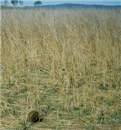Scientific name(s)
Sorghum hybrid
Strengths
- Large seed.
- Easy to harvest, handle and sow.
- Can be drilled into moist soil
- Good emergence from depth(to 50mm).
- Easy to establish on heavy black cracking-clay soils.
- Vigorous seedlings.
- High growth rate.
- Moderate drought tolerance.
- Tolerant of temporary waterlogging.
Limitations
- Needs moderate to high fertility.
- Intolerant of heavy grazing.
- Can cause prussic acid poisoning under some conditions
Plant description
Plant: An erect, robust, short-lived perennial tussock grass with numerous tillers growing to about 3.5 m in height at maturity under good conditions. Short rhizomes that curve upwards to produce new shoots usually 5 - 10 cm from the parent plant.
Stems: Stems usually robust (about 1 cm in diameter) and erect.
Leaves: Leaves about 3 cm across, tapering to a fine point and with a membranous ligule.
Seedhead: Seedhead is a large open pyramidal panicle with secondary and tertiary branches.
Seeds: 150,000 seeds/kg
Pasture type and use
It is used as a short-term perennial pasture, or as a short-term component of permanent pasture mixtures.
Where it grows
Rainfall
Usually sown in areas with 500 - 1200 mm/yr.
Soils
Adapted to fertile loams to heavy black clays.
Temperature
Grows during the warm season, and tops are killed by heavy frost.
Establishment
Companion species
Grasses: Angleton grass, Bambatsi panic, creeping bluegrass, rhodes grass.
Legumes: Annual medics, burgundy bean, butterfly pea, llanos macro (NT), lucerne, stylos, Oolloo centro (NT).
Sowing/planting rates as single species
3 - 4 kg/ha.
Sowing/planting rates in mixtures
1 - 2 kg/ha.
Sowing time
Sown from spring to late summer.
Inoculation
Not applicable
Fertiliser
Fertiliser is not required for establishment on suitable fallowed soil.
Management
Maintenance fertliser
100 kg N/ha/yr is needed to maintain high production and to improve persistence.
Grazing/cutting
Benefits from a periodic ungrazed period in the growing season and it can be cut for hay.
Seed production
250 - 500 kg/ha/yr.
Ability to spread
It spreads by seed on bare fertile soil and expands by short rhizomes.
Weed potential
It has low weed potential in native pastures, but is a significant weed in some cropping lands. It is a declared weed in some NSW Shires.
Major pests
Sorghum midge can reduce seed production.
Major diseases
Ergot may greatly reduce seed production.
Herbicide susceptibility
It is killed by glyphosate and is tolerant of atrazine.
Animal production
Feeding value
Nutritive value depends on soil fertility. It provides good yields only on soils which are at least moderately fertile. Nitrogen fertiliser increases forage yield and feed quality.
Palatability
It is very palatable.
Production potential
Under continuous grazing in sub-humid Australia, steers grazing at stocking rates of 1.5 - 3/ha averaged 150 kg/hd/yr liveweight gain.
Livestock disorders/toxicity
Prussic acid poisoning may result in cattle and sheep, especially hungry animals, grazing young, droughted sorghum pastures usually less than 1 m high.
Cultivars
| Cultivar | Seed source/Information |
| Silk | Australian Herbage Plant Cultivars |
| Liverpool Plains Shire Council | |
| Jaffa | Progressive Seeds |
Further information
Tropical Forages database (SoFT) - Perennial forage sorghum
Grassland Species Profile (FAO)
Agnote 784 - Silk sorghum (NTDPI)
Acknowledgements
-
Author and date
Dr Walter Scattini
December 2008






